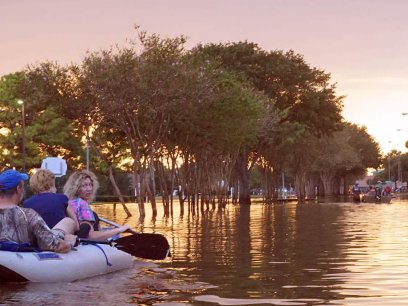
Emma “Grandma” Gatewood might be Ohio’s most famous hiker.
Despite her nickname, she was actually a great-grandmother when she completed the entire 2,055- (now 2,168) mile Appalachian Trail in 1955, the first woman to hike the entire length alone. In 1957, she completed her second thru-hike of the AT. Then, in 1964—at age 76—she became the first person to hike the trail three times.
Gatewood hiked more than 14,000 miles during her lifetime, the equivalent of more than halfway around the earth. Her inspiring story of healing through nature is carried on today, a reminder that the outdoors are for all ages.
Inspiring Elder Outdoorists
While a younger demographic is often featured in outdoor magazines and advertising, you don’t have to look far for examples of older adults who are staying active in nature.
Lou Batori was a local legend who skied Michigan’s Crystal Mountain until his passing at age 107. Pennsylvanian Joe Humphreys is still fly fishing at age 92 (a documentary, “Live the Stream,” was made about his life and work on the water). And this year, 75-year-old mountaineer Arthur Muir became the oldest American to summit Mount Everest.
Of course, outdoor activity doesn’t have to be extreme. It can take many forms, such as participating in a yoga class in a local park, going for a stroll, or simply making a long phone call in an outdoor setting. According to a 2021 survey, hiking and fishing are the top two most popular outdoor activities for adults over age 55.

The Healing Powers of Nature
Hiking is popular for good reason. Walking in nature promotes total health, both physical and mental.
A study from the American Cancer Society found that people—especially seniors—who walked just under two hours per week had a lower risk of death than those who did not. Life expectancy, obesity, type 2 diabetes, cardiovascular disease, mental illness, and even quality of sleep have all been shown to improve with increased physical activity.
Large epidemiological studies in Canada, Denmark, Japan, and the Netherlands found that simply having access to nature lowers rates of cardiovascular disease, stroke, obesity, and depression and is associated with better immune system functioning and fewer health problems. Forest bathing offers therapeutic effects for the elderly, reducing blood pressure and inflammation.
The Brain Benefits of Hiking
Hiking has also been shown to directly benefit the brain, including in adults that have already experienced mild cognitive impairment. As one physician put it: “exercise can turn back the clock in the brain.”
“Brain fog” is a common issue characterized by fatigue and loss of memory and concentration. Exercise has been shown to lessen the effects of brain fog for cancer patients undergoing chemotherapy and those battling “Long COVID”. Staying active improves your thinking skills by promoting gray matter retention in your brain, which helps you process information. Research also shows that spending time in nature reduces stress, which can help clear brain fog, too.
Heading out on a hiking trail challenges your hippocampus and exercises your spatial navigation and memory. It supports neuroplasticity, your nervous system’s ability to reorganize its structure, functions, or connections to adapt to new demands and information.
Tips to Help Older Adults Safely Get Outdoors
People who are living with chronic illness, disability, and progressing old age may not hike as long or as far—or experience nature in the same ways—as they did earlier in life. But nature can still help them stay active physically, spiritually, and socially. Connecting regularly with “green” and “blue” spaces (environments with running or still water) offers many benefits.
Before hitting the trails to enjoy the physical and mental health benefits of hiking, older adults should consider this checklist.
- Check with your doctor first. Make sure you are cleared for exercise before participating in any physical activity that is outside your norm.
- Choose the trail that is right for you. Research trails ahead of time and find one with the terrain and length that fits your physical abilities. There is a trail for everyone!
- Be prepared. Before you head out on a trail, be sure you are equipped with the “ten essentials,” including navigation, the right clothing, and extra food and water.
- Slowly increase distance and elevation gain. Don’t overdo it on your first hike. Stretching and body weight exercises can help improve your hiking stamina over time.
- Stay safe. Carry your ID with emergency contact information and bring a small amount of money and a cell phone with you. Let others know where you’re going and when you plan to be back.
- Avoid heat-related or cold-related illness. Check the weather before you go. Pick the right clothes. Stay hydrated. Learn the signs of hyper- and hypothermia.
- Listen to your body. If you don’t feel well on the trail, don’t push through. Head home, rest up, and try again.
- Prioritize everyday contact with nature. If you physically aren’t able to hike, you can still improve your mental and social wellbeing by sitting in a park, listening to a water fountain, or even looking at potted plants on a windowsill.
- Read more safety tips for exercising outdoors from the National Institute on Aging.
- Get your National Park Service Senior Pass. US citizens or permanent residents ages 62 or older are eligible to purchase a lifetime Senior Pass to receive access to more than 2,000 recreation sites managed by six federal agencies.
If you or a loved one need access to free and confidential mental health resources, the CDC has more information.


